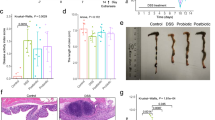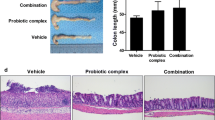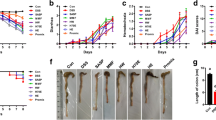Abstract
Use of probiotic therapy is an active area of investigation to treat intestinal disorders. The clinical benefits of the I3.1 probiotic formula (Lactobacillus plantarum (CECT7484, CECT7485) and P. acidilactici (CECT7483)) were demonstrated in irritable bowel syndrome (IBS) patients in a randomized, double-blind, placebo-controlled clinical trial. The aim of this study was to evaluate the therapeutic effects of I3.1 in two experimental models of colitis, a dextran sulfate sodium (DSS)-induced colitis model and an interleukin (IL)-10-deficient mice model. Colitis was induced in 32 8-week-old Balb/c mice by administering 3% (w/v) DSS in drinking water for 5 days. Probiotics were administered orally (I3.1 or VSL#3, 1 × 109 CFU daily) for 10 days before the administration of DSS. Also, probiotics (I3.1 or VSL#3, 1 × 109 CFU daily) were administered orally to 36 6-week-old C57B6J IL-10(−/−) mice for 10 weeks. Body weight was recorded daily. Colon samples were harvested for histological examination and cytokine measurements. Body weight after DSS administration did not change in the I3.1 group, whereas the VSL#3 group had weight loss. Also, I3.1 normalized IL-6 to levels similar to that of healthy controls and significantly increased the reparative histologic score. In the IL-10-deficient model, both VSL#3 and I3.1 reduced the severity of colitis compared to untreated controls, and I3.1 significantly reduced the levels of IFN-γ compared to the other two groups. In conclusion, I3.1 displays a protective effect on two murine models of experimental colitis. Results suggest that the mechanism of action could be different from VSL#3.




Similar content being viewed by others
References
Ananthakrishnan AN (2015) Epidemiology and risk factors for IBD. Nat Rev Gastroenterol Hepatol 12:205–217
Kau AL, Ahern PP, Griffin NW et al (2011) Human nutrition, the gut microbiome and the immune system. Nature 474:327–336
Bellaguarda E, Chang E (2015) IBD and the gut microbiota—from bench to personalized medicine. Curr Gastroenterol Rep 17:1–13
Wasilewski A, Zielinska M, Storr M et al (2015) Beneficial effects of probiotics, prebiotics, synbiotics, and psychobiotics in inflammatory bowel disease. Inflamm Bowel Dis 21:1674–1682
Ghouri YA, Richards DM, Rahimi EF et al (2014) Systematic review of randomized controlled trials of probiotics, prebiotics, and synbiotics in inflammatory bowel disease. Clin Exp Gastroenterol 7:473–487
Fedorak RN, Feagan BG, Hotte N et al (2015) The probiotic VSL#3 has anti-inflammatory effects and could reduce endoscopic recurrence after surgery for Crohn’s disease. Clin Gastroenterol Hepatol 13:928–935.e2
Jonkers D, Penders J, Masclee A et al (2012) Probiotics in the management of inflammatory bowel disease: a systematic review of intervention studies in adult patients. Drugs 72:803–823
Cooper HS, Murthy SN, Shah RS et al (1993) Clinicopathologic study of dextran sulfate sodium experimental murine colitis. Lab Investig 69:238–249
Chassaing B, Aitken JD, Malleshappa M et al (2014) Dextran sulfate sodium (DSS)-induced colitis in mice. Curr Protoc Immunol 104 Unit 15.25
Rakoff-Nahoum S, Paglino J, Eslami-Varzaneh F et al (2004) Recognition of commensal microflora by toll-like receptors is required for intestinal homeostasis. Cell 118:229–241
Berg DJ, Davidson N, Kühn R et al (1996) Enterocolitis and colon cancer in interleukin-10-deficient mice are associated with aberrant cytokine production and CD4(+) TH1-like responses. J Clin Invest 98:1010–1020
Schultz M, Veltkamp C, Dieleman LA et al (2002) Lactobacillus plantarum 299 V in the treatment and prevention of spontaneous colitis in interleukin-10-deficient mice. Inflamm Bowel Dis 8:71–80
Sellon RK, Tonkonogy S, Schultz M et al (1998) Resident enteric bacteria are necessary for development of spontaneous colitis and immune system activation in interleukin-10-deficient mice. Infect Immun 66:5224–5231
Madsen KL, Doyle JS, Jewell LD et al (1999) Lactobacillus species prevents colitis in interleukin 10 gene-deficient mice. Gastroenterology 116:1107–1114
Etling MR, Davies S, Campbell M et al (2007) Maturation of the mucosal immune system underlies colitis susceptibility in interleukin-10-deficient (IL-10−/−) mice. J Leukoc Biol 82:311–319
Lorenzo-Zúñiga V, Llop E, Suárez C et al (2014) I.31, a new combination of probiotics, improves irritable bowel syndrome-related quality of life. World J Gastroenterol 20:8709–8716
Martinez C, Vicario M, Ramos L et al (2012) The jejunum of diarrhea-predominant irritable bowel syndrome shows molecular alterations in the tight junction signaling pathway that are associated with mucosal pathobiology and clinical manifestations. Am J Gastroenterol 107:736–746
Chadwick VS, Chen W, Shu D et al (2002) Activation of the mucosal immune system in irritable bowel syndrome. Gastroenterology 122:1778–1783
Talley NJ (2006) Irritable bowel syndrome. Intern Med J 36:724–728
Piche T, Barbara G, Aubert P et al (2009) Impaired intestinal barrier integrity in the colon of patients with irritable bowel syndrome: involvement of soluble mediators. Gut 58:196–201
Dieleman LA, Palmen MJ, Akol H et al (1998) Chronic experimental colitis induced by dextran sulphate sodium (DSS) is characterized by Th1 and Th2 cytokines. Clin Exp Immunol 114:385–391
Mañé J, Pedrosa E, Lorén V et al (2009) Partial replacement of dietary (n-6) fatty acids with medium-chain triglycerides decreases the incidence of spontaneous colitis in interleukin-10-deficient mice. J Nutr 139:603–610
Murthy SN, Cooper HS, Shim H et al (1993) Treatment of dextran sulfate sodium-induced murine colitis by intracolonic cyclosporin. Dig Dis Sci 38:1722–1734
Pedrosa E, Lorén V, Cabré E et al (2011) Bacteria and spontaneous experimental colitis: immunological changes. Eur J Clin Investig 41:1047–1053
Nguyen TLA, Vieira-Silva S, Liston A et al (2015) How informative is the mouse for human gut microbiota research? Dis Model Mech 8:1–16
Melgar S, Karlsson A, Michaëlsson E (2005) Acute colitis induced by dextran sulfate sodium progresses to chronicity in C57BL/6 but not in BALB/c mice: correlation between symptoms and inflammation. Am J Physiol Gastrointest Liver Physiol 288:G1328–G1338
Fitzpatrick LR, Hertzog KL, Quatse AL et al (2007) Effects of the probiotic formulation VSL#3 on colitis in weanling rats. J Pediatr Gastroenterol Nutr 44:561–570
Mennigen R, Nolte K, Rijcken E et al (2009) Probiotic mixture VSL#3 protects the epithelial barrier by maintaining tight junction protein expression and preventing apoptosis in a murine model of colitis. Am J Physiol Gastrointest Liver Physiol 296:G1140–G1149
Mar JS, Nagalingam NA, Song Y et al (2014) Amelioration of DSS-induced murine colitis by VSL#3 supplementation is primarily associated with changes in ileal microbiota composition. Gut Microbes 5:494–503
McLean MH, Dieguez D, Miller LM et al (2015) Does the microbiota play a role in the pathogenesis of autoimmune diseases? Gut 64:332–341
Peterson CT, Sharma V, Elmén L et al (2015) Immune homeostasis, dysbiosis and therapeutic modulation of the gut microbiota. Clin Exp Immuno 179:363–377
Darfeuille-Michaud A, Boudeau J, Bulois P et al (2004) High prevalence of adherent-invasive Escherichia coli associated with ileal mucosa in Crohn’s disease. Gastroenterology 127:412–421
Machiels K, Joossens M, Sabino J et al (2014) A decrease of the butyrate-producing species Roseburia hominis and Faecalibacterium prausnitzii defines dysbiosis in patients with ulcerative colitis. Gut 63:1275–1283
Shukla R, Ghoshal U, Dhole TN et al (2015) Fecal microbiota in patients with irritable bowel syndrome compared with healthy controls using real-time polymerase chain reaction: an evidence of dysbiosis. Dig Dis Sci 60:2953–2962
Pagnini C, Saeed R, Bamias G et al (2010) Probiotics promote gut health through stimulation of epithelial innate immunity. Proc Natl Acad Sci U S A 107:454–459
Bassaganya-Riera J, Viladomiu M, Pedragosa M et al (2012) Immunoregulatory mechanisms underlying prevention of colitis-associated colorectal cancer by probiotic bacteria. PLoS One 7:e34676
von Schillde M-A, Hörmannsperger G, Weiher M et al (2012) Lactocepin secreted by Lactobacillus exerts anti-inflammatory effects by selectively degrading proinflammatory chemokines. Cell Host Microbe 11:387–396
Gionchetti P, Rizzello F, Venturi A et al (2000) Oral bacteriotherapy as maintenance treatment in patients with chronic pouchitis: a double-blind, placebo-controlled trial. Gastroenterology 119:305–309
Tursi A, Brandimarte G, Papa A et al (2010) Treatment of relapsing mild-to-moderate ulcerative colitis with the probiotic VSL#3 as adjunctive to a standard pharmaceutical treatment: a double-blind, randomized, placebo-controlled study. Am J Gastroenterol 105:2218–2227
Guandalini S, Magazzù G, Chiaro A et al (2010) VSL#3 improves symptoms in children with irritable bowel syndrome: a multicenter, randomized, placebo-controlled, double-blind, crossover study. J Pediatr Gastroenterol Nutr 51:24–30
Yadav V, Varum F, Bravo R et al (2016) Inflammatory bowel disease: exploring gut pathophysiology for novel therapeutic targets. Transl Res 176:38–68
Neurath MF (2014) New targets for mucosal healing and therapy in inflammatory bowel diseases. Mucosal Immunol 7:6–19
Ito H, Takazoe M, Fukuda Y et al (2004) A pilot randomized trial of a human anti-interleukin-6 receptor monoclonal antibody in active Crohn’s disease. Gastroenterology 126:989–996
Taniguchi K, Wu L-W, Grivennikov SI et al (2015) A gp130–Src–YAP module links inflammation to epithelial regeneration. Nature 519:57–62
Grivennikov S, Karin E, Terzic J et al (2009) IL-6 and Stat3 are required for survival of intestinal epithelial cells and development of colitis-associated cancer. Cancer Cell 15:103–113
Tanaka T, Narazaki M, Kishimoto T (2012) Therapeutic targeting of the interleukin-6 receptor. Annu Rev Pharmacol Toxicol 52:199–219
Tursi A, Elisei W, Brandimarte G et al (2011) Tumour necrosis factor-alpha expression in segmental colitis associated with diverticulosis down-regulates after treatment. J Gastrointestin Liver Dis 20:365–370
Dai C, Zheng C-Q, Meng F-J et al (2013) VSL#3 probiotics exerts the anti-inflammatory activity via PI3k/Akt and NF-κB pathway in rat model of DSS-induced colitis. Mol Cell Biochem 374:1–11
Büchler G, Wos-Oxley ML, Smoczek A et al (2012) Strain-specific colitis susceptibility in IL10-deficient mice depends on complex gut microbiota-host interactions. Inflamm Bow Dis 18:943–954
Maharshak N, Packey CD, Ellermann M et al (2013) Altered enteric microbiota ecology in interleukin 10-deficient mice during development and progression of intestinal inflammation. Gut Microbes 4:316–324
Madsen K, Cornish A, Soper P et al (2001) Probiotic bacteria enhance murine and human intestinal epithelial barrier function. Gastroenterology 121:580–591
Takayama T, Kamada N, Chinen H et al (2010) Imbalance of NKp44(+)NKp46(−) and NKp44(−)NKp46(+) natural killer cells in the intestinal mucosa of patients with Crohn’s disease. Gastroenterology 139:882–892
Gonsky R, Deem RL, Landers CJ et al (2011) Distinct IFNG methylation in a subset of ulcerative colitis patients based on reactivity to microbial antigens. Inflamm Bowel Dis 17:171–178
Darkoh C, Comer L, Zewdie G et al (2014) Chemotactic chemokines are important in the pathogenesis of irritable bowel syndrome. PLoS One 9:e93144
Montufar-Solis D, Schaefer J, Hicks MJ et al (2008) Massive but selective cytokine dysregulation in the colon of IL-10−/− mice revealed by multiplex analysis. Int Immunol 20:141–154
Gomes-Santos AC, Moreira TG, Castro-Junior AB et al (2012) New insights into the immunological changes in IL-10-deficient mice during the course of spontaneous inflammation in the gut mucosa. Clin Dev Immunol. doi:10.1155/2012/560817
Liu Z, Zhang P, Ma Y et al (2011) Lactobacillus plantarum prevents the development of colitis in IL-10-deficient mouse by reducing the intestinal permeability. Mol Biol Rep 38:1353–1361
Kühn R, Löhler J, Rennick D et al (1993) Interleukin-10-deficient mice develop chronic enterocolitis. Cell 75:263–274
Clark E, Hoare C, Tanianis-Hughes J et al (2005) Interferon gamma induces translocation of commensal Escherichia coli across gut epithelial cells via a lipid raft-mediated process. Gastroenterology 128:1258–1267
Sarrabayrouse G, Bossard C, Chauvin JM et al (2014) CD4CD8αα lymphocytes, a novel human regulatory T cell subset induced by colonic bacteria and deficient in patients with inflammatory bowel disease. PLoS Biol 12:e1001833
Yadav H, Lee J-H, Lloyd J et al (2013) Beneficial metabolic effects of a probiotic via butyrate-induced GLP-1 hormone secretion. J Biol Chem 288:25088–25097
Dai C, Zhao DH, Jiang M et al (2012) VSL#3 probiotics regulate the intestinal epithelial barrier in vivo and in vitro via the p38 and ERK signaling pathways. Int J Mol Med 29:202–208
Ishiguro K, Ando T, Maeda O et al (2014) Suppressive action of acetate on interleukin-8 production via tubulin-[alpha] acetylation. Immunol Cell Biol 92:624–630
Macia L, Tan J, Vieira AT et al (2015) Metabolite-sensing receptors GPR43 and GPR109A facilitate dietary fibre-induced gut homeostasis through regulation of the inflammasome. Nat Commun 6:6734
Duncan SH, Hold GL, Barcenilla A et al (2002) Roseburia intestinalis sp. nov., a novel saccharolytic, butyrate-producing bacterium from human faeces. Int J Syst Evol Microbiol 52:1615–1620
Duncan SH, Hold GL, Harmsen HJM et al (2002) Growth requirements and fermentation products of fusobacterium prausnitzii, and a proposal to reclassify it as Faecalibacterium prausnitzii gen. nov., comb. Nov. Int J Syst Evol Microbiol 52:2141–2146
Segawa S, Fujiya M, Konishi H et al (2011) Probiotic-derived polyphosphate enhances the epithelial barrier function and maintains intestinal homeostasis through integrin–p38 MAPK pathway. PLoS One 6:e23278
Tanaka K, Fujiya M, Konishi H et al (2015) Probiotic-derived polyphosphate improves the intestinal barrier function through the caveolin-dependent endocytic pathway. Biochem Biophys Res Commun 467:541–548
Author information
Authors and Affiliations
Corresponding author
Ethics declarations
Conflict of Interest
V. Lorén, J. Manyé, E. Cabré and I. Ojanguren declare that they have no conflict of interest. M.C Fuentes and J. Espadaler are full-time employees of AB-Biotics S.A.
Rights and permissions
About this article
Cite this article
Lorén, V., Manyé, J., Fuentes, M.C. et al. Comparative Effect of the I3.1 Probiotic Formula in Two Animal Models of Colitis. Probiotics & Antimicro. Prot. 9, 71–80 (2017). https://doi.org/10.1007/s12602-016-9239-5
Published:
Issue Date:
DOI: https://doi.org/10.1007/s12602-016-9239-5




